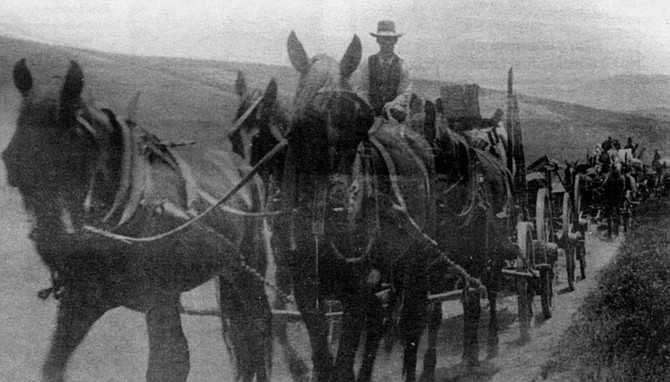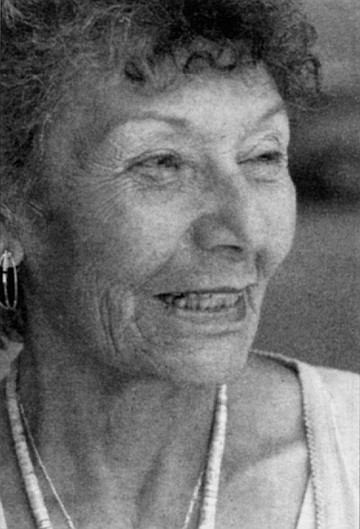 Facebook
Facebook
 X
X
 Instagram
Instagram
 TikTok
TikTok
 Youtube
Youtube

Every year, a week before Cupa Days, we make the journey back to Warner’s,” says Leroy H. Miranda, Jr., director of the Cupa Cultural Center in Pala. He refers to Warner Springs, where the Cupeño Indians lived until a U.S. Supreme Court decision forced their relocation to Pala. Cupa Days is the name of the festival held for the past 27 years in Pala on the first weekend in May. Miranda says it’s meant to be a remembrance of “the removal” on May 12,1903.

The tribe has always been among the smallest in Southern California. Estimates say it never numbered over 1000. Today the Cupeños, combined with the Luiseños, on whose land the Cupeños were relocated, have a combined membership of under 900. Fifty to 100 of them make the trek to Warner Springs, says Miranda.
“We go up there and say a morning-service prayer. We go to the springs, have a meal, remember our ancestral home, and prepare ourselves for the upcoming event. When we lived in Warner’s,” adds Miranda, who is in his early 30s, so he is speaking collectively, “we lived right where the [Warner Springs Ranch] resort is today. That water was medicine for us, our everything for us. And so we go up there to gather it again, bring it home in bottles. It’s our life, our power.”
Tribal elder Nadean Nelson won’t be in the group making the trip 40 miles to the north of Pala. Born in 1919, the 82-year-old Nelson says, “Four women in my family were removed from Warner’s — my mother, grandmother, great grandmother, and great-great grandmother.” But they didn’t return to the springs, either. “I imagine that to them it would have been very painful. Besides, they tried to put that behind them. Not that they forgot it, but you go forward is what I was taught.” Then, apropos of moving forward, she asks, “Have you been to our casino?”
Just barely one month old, it is. Nelson says, “Beautiful, just beautiful. They have three displays, one at each entrance.” Nelson was their curator, gathering the material, formulating the story lines, writing the captions. “These displays tell the story of our life, our removal from Warner’s, in pictures. We really don’t have artifacts, because when we were removed, we couldn’t bring anything except what we could get in a wagon.”
A number of the photographs are her own family’s; the stories are ones she was told as a child. “Because I was an only child, I had a big advantage in that I was spoken to as an adult and everything was shared with me. I was not sent out of the room.”
Asked if the idea of the change that a casino will bring worries her. Nelson says, “Our removal from Warner’s was change, and change is always going on, but in subtler ways. I’m hoping this will be a good change. It probably won’t be for some,” she grants. But for most she foresees benefits. “It will help them have more and be able to do more to help themselves. You know, I planted some apple trees, and they’ve all died from lack of water and other things I couldn’t supply. So you can’t do much with what you have if you don’t have money to do it with.
“I know a lot of people who say, 'Why don’t they do this or that [instead of having a casino]?’ But we have a very nice casino. It’s not like others I’ve seen. We waited until everything was right, so it wasn’t built piecemeal. We have a little mall, a little entertainment, and nice places where you can bring friends to lunch. It’s not just hitting you with machines."
Nelson has lived in Pala “almost” all her life. She says “almost" because, for 20 years, she experienced life in many other parts of the country and the world while traveling with her husband, a U.S. Air Force pilot. One of their two daughters was born in Japan. “So I have seen how other people live and seen that some were poor, like us. But I think our people have had a better chance than many. And now we have more of a chance because of this casino. Our infrastructure, our little town, can become a better place.”
Nelson understands why younger generations tend to focus on the anniversary of the dramatic removal. And she will, of course, attend the Cupa Days, as always, enjoying the dance program, musk, crafts, and food. But for her a more important date to remember is June 2, 1924. That’s when her people finally achieved citizenship.
“Can you imagine? It was in my lifetime. The younger ones don’t realize. My grandmother, Salvadora Griffith Valenzuela, was a staunch member of the organization, called the Federation, that worked so hard to make it happen, sewing quilts to raise money to send the men to Sacramento and Washington. That’s a whole big, long story, too, but it’s there, in the displays at the casino.”


Every year, a week before Cupa Days, we make the journey back to Warner’s,” says Leroy H. Miranda, Jr., director of the Cupa Cultural Center in Pala. He refers to Warner Springs, where the Cupeño Indians lived until a U.S. Supreme Court decision forced their relocation to Pala. Cupa Days is the name of the festival held for the past 27 years in Pala on the first weekend in May. Miranda says it’s meant to be a remembrance of “the removal” on May 12,1903.

The tribe has always been among the smallest in Southern California. Estimates say it never numbered over 1000. Today the Cupeños, combined with the Luiseños, on whose land the Cupeños were relocated, have a combined membership of under 900. Fifty to 100 of them make the trek to Warner Springs, says Miranda.
“We go up there and say a morning-service prayer. We go to the springs, have a meal, remember our ancestral home, and prepare ourselves for the upcoming event. When we lived in Warner’s,” adds Miranda, who is in his early 30s, so he is speaking collectively, “we lived right where the [Warner Springs Ranch] resort is today. That water was medicine for us, our everything for us. And so we go up there to gather it again, bring it home in bottles. It’s our life, our power.”
Tribal elder Nadean Nelson won’t be in the group making the trip 40 miles to the north of Pala. Born in 1919, the 82-year-old Nelson says, “Four women in my family were removed from Warner’s — my mother, grandmother, great grandmother, and great-great grandmother.” But they didn’t return to the springs, either. “I imagine that to them it would have been very painful. Besides, they tried to put that behind them. Not that they forgot it, but you go forward is what I was taught.” Then, apropos of moving forward, she asks, “Have you been to our casino?”
Just barely one month old, it is. Nelson says, “Beautiful, just beautiful. They have three displays, one at each entrance.” Nelson was their curator, gathering the material, formulating the story lines, writing the captions. “These displays tell the story of our life, our removal from Warner’s, in pictures. We really don’t have artifacts, because when we were removed, we couldn’t bring anything except what we could get in a wagon.”
A number of the photographs are her own family’s; the stories are ones she was told as a child. “Because I was an only child, I had a big advantage in that I was spoken to as an adult and everything was shared with me. I was not sent out of the room.”
Asked if the idea of the change that a casino will bring worries her. Nelson says, “Our removal from Warner’s was change, and change is always going on, but in subtler ways. I’m hoping this will be a good change. It probably won’t be for some,” she grants. But for most she foresees benefits. “It will help them have more and be able to do more to help themselves. You know, I planted some apple trees, and they’ve all died from lack of water and other things I couldn’t supply. So you can’t do much with what you have if you don’t have money to do it with.
“I know a lot of people who say, 'Why don’t they do this or that [instead of having a casino]?’ But we have a very nice casino. It’s not like others I’ve seen. We waited until everything was right, so it wasn’t built piecemeal. We have a little mall, a little entertainment, and nice places where you can bring friends to lunch. It’s not just hitting you with machines."
Nelson has lived in Pala “almost” all her life. She says “almost" because, for 20 years, she experienced life in many other parts of the country and the world while traveling with her husband, a U.S. Air Force pilot. One of their two daughters was born in Japan. “So I have seen how other people live and seen that some were poor, like us. But I think our people have had a better chance than many. And now we have more of a chance because of this casino. Our infrastructure, our little town, can become a better place.”
Nelson understands why younger generations tend to focus on the anniversary of the dramatic removal. And she will, of course, attend the Cupa Days, as always, enjoying the dance program, musk, crafts, and food. But for her a more important date to remember is June 2, 1924. That’s when her people finally achieved citizenship.
“Can you imagine? It was in my lifetime. The younger ones don’t realize. My grandmother, Salvadora Griffith Valenzuela, was a staunch member of the organization, called the Federation, that worked so hard to make it happen, sewing quilts to raise money to send the men to Sacramento and Washington. That’s a whole big, long story, too, but it’s there, in the displays at the casino.”
Comments